= Tephrocactus articulatus var. papyracanthus (Phil.) Backeb.
Cactus (Paris) no. 38: 249. 1953
Accepted Scientific Name: Tephrocactus articulatus (Pfeiff.) Backeb.
Cactus (Paris) No. 38, 249 (1953); cf. Gray Herb. Card Cat.
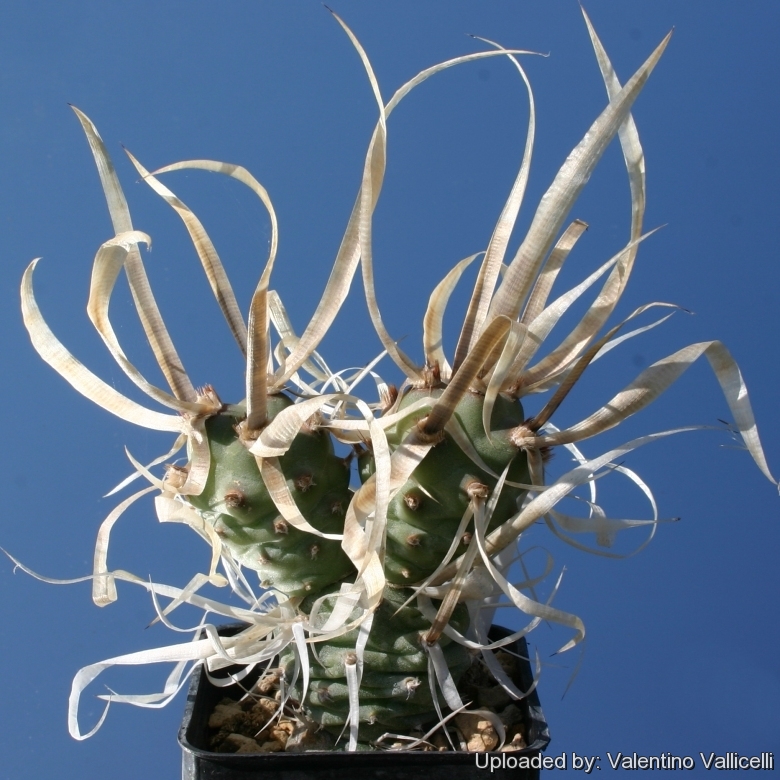
Opuntia papyracantha (Tephrocactus articulatus var. papyracanthus) Photo by: Valentino Vallicelli
Origin and Habitat: Western Argentina.
Synonyms:
See all synonyms of Tephrocactus articulatus
back
Accepted name in llifle Database:Tephrocactus articulatus (Pfeiff.) Backeb.Cactus (Paris) No. 38, 249 (1953); cf. Gray Herb. Card Cat.Synonymy: 44
back
Common Names include:
ENGLISH: Paper Spine Cactus, Paper Spine Cholla Cactus.
Description: Segmented bushy succulent slowly growing up to up to 30 cm, it is the typical form of a group of variety.
Stems: It develops in little pine-cone shaped segments that are loosely attached to each other and fall easily.
Spines: This species is very variable as to whether it is spine-bearing or not. The spiny form (also known as "papyracanthus") have broad, raffia like, conspicuous , flattened spines which are not spines but thin ribbon like processes, and vary much as to their colour, markings, and length. This variation are partly the cause of so many synonyms for the species.
Flowers: Blooms are either white or yellow. The white flowers made a nice contrast to the earth-tone colours of the plant.
Fruit: 1 to 5 cm long fruit is brown.
More...Subspecies, varieties, forms and cultivars of plants belonging to the Tephrocactus articulatus group
- Tephrocactus andicolus (Pfeiff.) Lem.
- Tephrocactus articulatus (Pfeiff.) Backeb.: Small branching shrublet. Segments, fragile, subglobose to short cylindrical, sometimes like a string of beads. Spines 1-4, or absent, flattened, flexible, up to 10 cm long and 4 mm wide or more.
 Tephrocactus articulatus var. diadematus f. inermis hort.: Cool looking pine-cone-like plant without spines and irritating glochids. The segment generally grow longer and narrower than the standard Tephrocactus articulatus.
Tephrocactus articulatus var. diadematus f. inermis hort.: Cool looking pine-cone-like plant without spines and irritating glochids. The segment generally grow longer and narrower than the standard Tephrocactus articulatus. - Tephrocactus articulatus var. ovatus (Pfeiff.) Backeb.
 Tephrocactus articulatus var. papyracanthus (tubercled type) hort.: Has raised conical tubercles.
Tephrocactus articulatus var. papyracanthus (tubercled type) hort.: Has raised conical tubercles. Tephrocactus articulatus var. papyracanthus (Phil.) Backeb.: has broad, raffia like, conspicuous, flattened spines which are not spines but thin ribbon like processes, and vary much as to their colour, markings, and length.
Tephrocactus articulatus var. papyracanthus (Phil.) Backeb.: has broad, raffia like, conspicuous, flattened spines which are not spines but thin ribbon like processes, and vary much as to their colour, markings, and length. Tephrocactus articulatus var. strobiliformis (A.Berger): Spineless form with grey-green pine-cone shaped segments that turns pink in bright light.
Tephrocactus articulatus var. strobiliformis (A.Berger): Spineless form with grey-green pine-cone shaped segments that turns pink in bright light.- Tephrocactus articulatus var. syringacanthus (Pfeiff.) Backeb.
- Tephrocactus turpinii (Lem.) Lem.
Notes: The little glochids at the areoles are quite a nuisance, and it is best to use gloves to handle this plant.
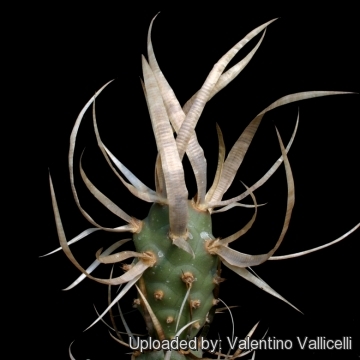 Opuntia papyracantha (Tephrocactus articulatus var. papyracanthus) Photo by: Valentino Vallicelli
Opuntia papyracantha (Tephrocactus articulatus var. papyracanthus) Photo by: Valentino Vallicelli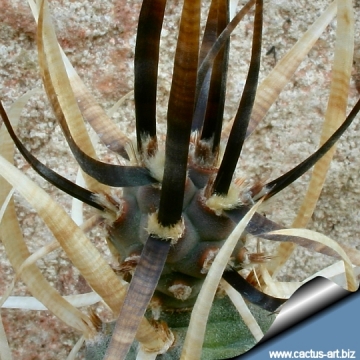 Opuntia papyracantha (Tephrocactus articulatus var. papyracanthus) Photo by: Cactus Art
Opuntia papyracantha (Tephrocactus articulatus var. papyracanthus) Photo by: Cactus Art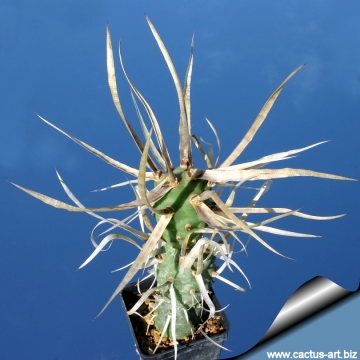 Opuntia papyracantha (Tephrocactus articulatus var. papyracanthus) Photo by: Cactus Art
Opuntia papyracantha (Tephrocactus articulatus var. papyracanthus) Photo by: Cactus Art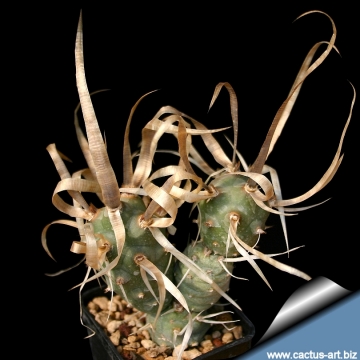 Opuntia papyracantha (Tephrocactus articulatus var. papyracanthus) Photo by: Cactus Art
Opuntia papyracantha (Tephrocactus articulatus var. papyracanthus) Photo by: Cactus ArtCultivation and Propagation: It is easy to grow but usually couldn’t get very tall as segment kept falling apart. It is fairly cold resistant and hardy to -9°C depending on the clone, Need full sun, (with insufficient illumination stems get thinner as a result of the lack of sun) The main growing period is spring. It might produce some new segments in the autumn too. Needs good drainage. Propagation is through segment cuttings, or occasionally seeds.
Propagation: Cuttings, it suckers profusely and is very easy to grow by just knocking off one of the 'cones' and stuffing it in the ground.















